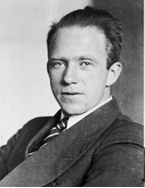 Quantum
mechanics is believed to be the underlying theory of the constituents of all
matter and energy. Every particle in the universe
Quantum
mechanics is believed to be the underlying theory of the constituents of all
matter and energy. Every particle in the universe  Quantum
mechanics is believed to be the underlying theory of the constituents of all
matter and energy. Every particle in the universe
Quantum
mechanics is believed to be the underlying theory of the constituents of all
matter and energy. Every particle in the universe has a quantum wavefunction
from which all of its behaviour and properties can be predicted. From drug
design to microelectronics, the wavefunction’s importance cannot be overstated.
The
wavefunction embodies the idea that every particle is also a wave. This wave is
much like the set of ripples travelling out from a pebble dropped in a pool. And the shape of this set of ripples is what is analogous to the wavefunction. A
feature of quantum mechanics is that, unlike a water wave, the very act of
observing the wavefunction changes it, making it a slippery object to measure.
For
example Heisenberg showed that if one observes exactly where a particle is then
you disturb it, forcing its velocity and direction to become completely random.
In our analogy, this would be like placing a coconut at a particular position
in the pool to see if the ripples would cause it to bob. As well as bobbing,
the coconut would have the unwanted side effect of reflecting the incoming
ripples and sending them in every which direction. Because of this inevitable
disturbance, right now scientists only measure the wavefunction indirectly, much
like looking only at the shadow a wave casts on the bottom of a pool.
 The obvious solution to this problem, to use a lighter float such as a wine cork,
is analogous to the solution for measuring the wavefunction. If one simply
measures the position of the particle gently in a ‘weak measurement’ then the
velocity does not become random. The catch is that one does not get much
information about the particle’s position from this weak measurement. The trick
is to repeat the gentle position measurement followed by the normal velocity
measurement over and over again on many identical wavefunctions until one has
enough information to say what the average result of the position measurement
is. This average is equal to the wavefunction itself.
The obvious solution to this problem, to use a lighter float such as a wine cork,
is analogous to the solution for measuring the wavefunction. If one simply
measures the position of the particle gently in a ‘weak measurement’ then the
velocity does not become random. The catch is that one does not get much
information about the particle’s position from this weak measurement. The trick
is to repeat the gentle position measurement followed by the normal velocity
measurement over and over again on many identical wavefunctions until one has
enough information to say what the average result of the position measurement
is. This average is equal to the wavefunction itself.